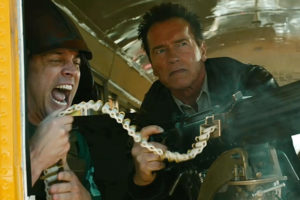If you were a child of the 1980s and you liked action movies, then you probably grew up on a steady diet of laconic, musclebound killing machines like Arnold Schwarzenegger and Sylvester Stallone. It’s a testament to the enduring charm of ‘80s action that the stars of that era are largely still working today. Schwarzenegger, the uncontested champion of that era, hasn’t done much film work in the past decade––apart from a handful of uncredited cameos––in favor of his political career. But now the star of such iconic action films as “Conan the Barbarian” (1982), “The Terminator” (1984), “Commando” (1985), and “Predator” (1987), is finally returning to leading roles. So how has the 65-year-old former ‘Mr. Universe’ held up during his hiatus? Not well, unfortunately. His ostensible comeback, “The Last Stand,” is rote, derivative, dull, and sorely lacking in action or excitement.
Schwarzenegger is Ray Owens, sheriff of a small Arizona border town. With most of the citizens away for a high school football road game, Owens expects a quiet weekend. Elsewhere, we see FBI Agent John Bannister (Forest Whitaker) preparing his team to transport dangerous Mexican drug lord Gabriel Cortez (Eduardo Noriega), but Cortez, with the aid of a group of lookalike decoys, manages to escape custody.
The agents eventually learn that Cortez is driving himself to the border in a powerful stolen concept car, and that his intended crossing is in Owens’ sleepy town. Cortez has a team of paramilitary laborers building a makeshift mobile assault bridge to get him across a canyon that lies south of town. Owens, along with his deputies, a former soldier imprisoned for theft, and a local gun nut, must take on Cortez and his cartel cronies, despite being out-manned and outgunned.

While that Joe Arpaio fever-dream of a plot seems simple enough, you might be surprised to learn that all of the preamble to the eponymous last stand takes up ninety minutes of the film’s 107-minute run-time. This might be the all-time most languid pacing in a purported action film. We are slowly introduced to Owens and each of the many major and minor players by excruciatingly hackneyed dialogue.
We also get countless scenes of Bannister in his command center, commenting aloud on off-screen maps or satellite imagery, or simply making phone calls to explain what is going on. Cortez’ escape, which offers no intrigue whatsoever, eats an unnecessary twenty-minute chunk of the early going, and is indicative of the film’s faulty approach. The narrative plods along so laboriously that any sense of buildup to the climax is squandered.
Even when we get to the last stand itself, nothing much of interest occurs. We veer between something approaching realism (the “good guys” spend most of the firefights hiding behind cover) and moments that attempt over-the-top humor (the combination of a flare and a few shotgun shells literally blowing a villain to pieces), with no consistency in tone or style.
The most physicality we see from the once-imposing Schwarzenegger is a trot up a few stairs; his most action-packed moments amount to a pair of instances of shooting while seated in a car. The ostensible villain, Cortez, exudes no menace (though he isn’t helped by the fact that 95% of his screen time is merely him sneering from behind the wheel). With all of this sitting and driving, you might think that the chases would at least be watchable, but atrociously poor cinematography and sloppy editing render anything but hints of excitement unseen.
If you love action movies and are a Schwarzenegger fan, your best course of action is to pretend this film never happened.
– by Demian Morrisroe
1 Comment
Pingback: » Eraser (R)